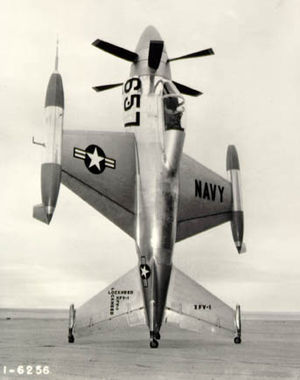Lockheed XFV
| XFV Salmon | |
|---|---|
 |
|
| Role | Experimental VTOL fighter aircraft |
| Manufacturer | Lockheed |
| First flight | 16 June 1954 |
| Primary user | United States Navy (intended) |
| Produced | 1954 |
| Number built | 1 flying prototype plus 1 incomplete airframe |
The American Lockheed XFV (sometimes referred to as the Salmon) was an experimental tailsitter prototype aircraft built by Lockheed in the early 1950s to demonstrate the operation of a vertical takeoff and landing fighter for protecting convoys.
The Lockheed XFV originated as a result of a proposal issued by the U.S. Navy in 1948 for an aircraft capable of vertical takeoff and landing (VTOL) aboard platforms mounted on the afterdecks of conventional ships. Both Convair and Lockheed competed for the contract but in 1950, the requirement was revised, with a call for a research aircraft capable of eventually evolving into a VTOL ship-based convoy escort fighter. On 19 April 1951, two prototypes were ordered from Lockheed under the designation XFO-1 (company designation was Model 081-40-01). Soon after the contract was awarded, the project designation changed to XFV-1 when the Navy's code for Lockheed was changed from O to V.
The XFV was powered by a 5,332 hp (3,976 kW) Allison YT40-A-6 turboprop engine driving three-bladed contra-rotating propellers. The tail surfaces were a reflected cruciform v-tail (forming an x) that extended above and below the fuselage. The aircraft had an ungainly appearance on the ground with a makeshift, fixed landing gear attached. Lockheed employees derisively nicknamed the aircraft the "pogo stick" (a direct reference to the rival Convair XFY's name).
To begin flight testing, a temporary non-retractable undercarriage with long braced V-legs was attached to the fuselage, and fixed tail wheels attached to the lower pair of fins. In this form, the aircraft was trucked to Edwards AFB in November 1953 for ground testing and taxiing trials. During one of these tests, at a time when the aft section of the large spinner had not yet been fitted, Lockheed Chief Test Pilot Herman "Fish" Salmon managed to taxi the aircraft past the liftoff speed, and the aircraft made a brief hop on 22 December 1953. The official first flight took place on 16 June 1954.
...
Wikipedia
